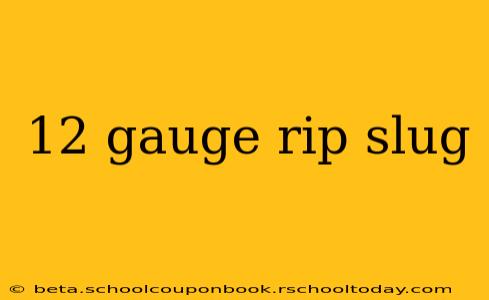The 12 gauge rifled slug is a formidable round, favored by hunters and home defense enthusiasts alike for its devastating power and accuracy at extended ranges. Understanding its capabilities, limitations, and proper usage is crucial for safe and effective deployment. This comprehensive guide explores the nuances of this powerful ammunition.
What is a 12 Gauge Rifled Slug?
A 12 gauge rifled slug differs significantly from a standard 12 gauge buckshot or birdshot round. Instead of containing numerous smaller projectiles, it fires a single, large projectile designed to engage targets at longer distances. The key distinction lies in the projectile itself: it features grooves along its exterior, engaging the rifling within a shotgun barrel specifically designed for slugs. This rifling imparts spin stabilization, dramatically increasing accuracy and range compared to smoothbore slugs.
Advantages of Using Rifled Slugs
Several advantages make rifled slugs a popular choice among firearm users:
-
Increased Accuracy: The rifling provides superior accuracy compared to smoothbore slugs, allowing for precise shots at considerably longer distances. This is crucial for hunting larger game or for self-defense situations requiring accurate shots at extended ranges.
-
Extended Range: The enhanced stability from the rifling allows rifled slugs to maintain their trajectory over greater distances, offering a significant advantage in hunting scenarios where targets are further away.
-
Greater Penetration: Compared to buckshot, rifled slugs offer superior penetration, making them effective against larger, more heavily built targets. This is particularly important for hunting larger animals.
-
Controlled Recoil: While still powerful, the design of rifled slugs often leads to slightly less felt recoil than some other types of 12 gauge ammunition. This can improve shooter comfort and accuracy, especially during extended shooting sessions.
Choosing the Right 12 Gauge Rifled Slug
The market offers a variety of 12 gauge rifled slugs, each with different characteristics:
-
Solid Slugs: These are typically made of lead or a lead alloy and offer excellent penetration.
-
Foster Slugs: A variation on the solid slug with a hollow base, sometimes offering a slightly reduced recoil.
-
Sabot Slugs: These use a plastic sabot (carrier) that separates from the slug after exiting the barrel. This allows for better accuracy and potentially longer ranges due to the reduced friction within the barrel. Sabot slugs are frequently made from lead, copper, or other materials.
Considerations for Safe and Effective Use
While powerful and accurate, 12 gauge rifled slugs demand responsible handling:
-
Barrel Considerations: Rifled slugs require shotguns with rifled barrels. Using rifled slugs in a smoothbore barrel can lead to dangerous accuracy issues and potential barrel damage.
-
Sight Alignment: Accurate shooting requires proper sighting. Using iron sights or scopes specifically designed for slug shooting is crucial.
-
Backstop: Due to the potent nature of these slugs, choosing a safe and appropriate backstop is vital for safe shooting practice and hunting.
-
Target Selection: Understand the capabilities and limitations of the slug. Select appropriate targets and ranges for safe and ethical use.
Conclusion
The 12 gauge rifled slug is a potent and precise round with applications in hunting and self-defense. Understanding its advantages, limitations, and proper usage is key to responsible firearm ownership. Always prioritize safety and adhere to all relevant firearm safety regulations.
